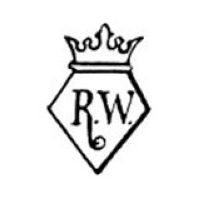
Image 011235-01-01
Used between 1895 and 1924, registered under RWZR №·16·682 on May 22nd 1896.
Until the year 2003 no business registered in Germany was allowed to include foreign company form designations or abbreviations thereof; only the legal German company forms (e.g. "KG", "OHG", "GmbH", "AG", etc.) themselves were allowed. Knowing that, it's easy to see that claims of the German company being named New York and Rudolstadt Pottery Co. Inc. are pure nonsense as the company had to use a German legal entity form. Another factor which lead to confusion in this matter was the fact that the marks registered in Germany were not applied for by the German subsidiary itself but were registered directly via the US mother company. This allowed it to keep hands on the marks even if the German subsidiary should turn bankrupt or run into other difficulties.
The company of Lazarus Straus & Sons was founded in 1869 and successfully specialized on the import and resale of glass and ceramics. By 1874 Nathan Straus (Lazarus' son) had convinced the company of R.H. Macy (Macy's) to allow small shop-in-shop based glass and chinaware department in each of their stores. Business quickly increased and so the US-based New York and Rudolstadt Pottery Co. Inc. was founded in 1882 with their subsidiary in Germany supplying the Straus business with own porcelain products in the range of luxury goods like figures, elaborate coffee sets and such. First director was their German relative Julius Straus. Technical director between 1882 and 1889 was Carl Louis Christian Eduard Müller who in 1890 founded his own porcelain company under the name of E.&A. Müller in the town of Schwarza-Saalbahn.
At first the company in Germany only concentrated on the items created in the Rudolstadt factory but with expanding business and the following opening of further subsidiaries in both France (decoration studio in the Limoges area) and Austrian Bohemia (second studio and warehouse near Carlsbad) in 1891 the Rudolstadt-based company also started to function as coordinator and export relay for all subsidiaries while the London-based (and more glass-related) business remained nearly independent. It shoud be mentioned here that already in 1913 the German factory employed around 300 workers, roughly one third of those were occupied with export transactions only.
The different subsidiaries used own marks and so one normally encounters specialized German, French or Austrian versions. However there also are two exceptions: next to the typical French L.S.&S. Limoges and Austrian L.S.&S. Carlsbad versions the most used mark is the German version showing a crowned lozenge with the initials "RW" standing for Rudolstadt Works. That mark together with the more elaborate "Crown Rudolstadt" type was not only used for the German business but also used for items from the Austrian Bohemian deals made exclusively with the company of Oscar & Edgar Gutherz. The reason for this deviation from the normal procedure of using the L.S.&S. Carlsbad mark like on items for example purchased from Moritz Zdekauer was that Lazarus' son Nathan as the main director of the German factory and central purchasing coordinator was married to the sister of Oscar and Edgar, Lena Gutherz. The business relationship by the way also included the financial backing of the Gutherz business by Straus & Sons and as if all that was not confusing enough Edgar Gutherz himself was actually married to a woman named Lina.
During the first years the company in Germany at first disregarded thoughts of marking their items but with increasing business and thoughts of further expansion it became obvious that one should introduce some sort of trademark. The first documented mark of the German company was the version registered on May 22nd 1896, which was introduced as an own marking for their products after the acquisition of Macy's department stores and was one of the last introductions by Lazarus Straus who died the same year. That first mark was used without additions until 1904 when the company registered another mark, the basic eagle-on-shield. Following the introduction of the eagle mark, the crowned "RW" was continued with the additions "Germany" and "Rudolstadt" until 1924, the year which not only saw the introduction of the (Royal) Schwarzburg mark but also the US company reforming under the name of Nathan Straus & Co..
In that context it should be mentioned that some sources incorrectly state that the "RW" mark was only used until 1918, the result of a translation error that has to do with various people and their connections to Straus & Sons. To keep it short, 1918 was the year that the Gutherz brothers together with other businessmen founded the OEPIAG (later EPIAG) and in this context the use of the old Straus import marking on Gutherz items was officially canceled while the mark itself remained in use until 1924.
Anyway, the Germany company over the years not only produced own items but also increased their work as coordinator for all European factories that supplied Straus until they were forced to close in 1930 following the drastic changes in worldwide economics.
Using the term "Royal Rudolstadt" in context with this manufacturer is highly misleading for potential customers as that registered trademark was owned by Beyer & Bock from the Volkstedt part of the city of Rudolstadt-Volkstedt. Claims of Straus being in US importer of Beyer & Bock items and thus being linked to the Royal Rudolstadt fame are as incorrect as can be; both companies never did any business together. In fact the two were harsh competitors and Straus never forgave Beyer & Bock their registration of the Royal Rudolstadt mark, a trademark Straus had unsuccessfully tried to acquire himself.
The misconception that the marketing term "Royal Rudolstadt" actually belonged to Straus & Sons is largely based on incorrect information published by the Kovels, who apparently simply copied incorrect information from a notoriously unreliable source, author Robert Röntgen. Not only did he screw up on the rightful trademark owner, he also claimed that the Straus mother company was named Lewis Straus & Sons and had resided in Germany under an English company name. Complete nonsense, as mentioned.
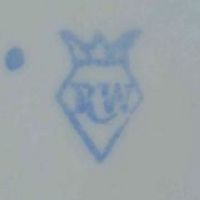
Image 011235-01-02
Used between 1895 and 1924, later used example (basic crown) in blue.
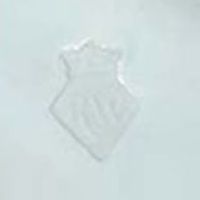
Image 011235-01-03
Used between 1895 and 1924, impressed version of previous mark.
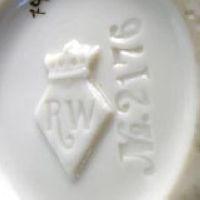
Image 011235-01-04
Used between 1895 and 1924, positive version of the same mark.
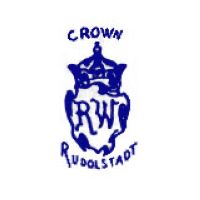
Image 011235-01-05
Used between 1900 and 1918, some say it's found on Gutherz products only.
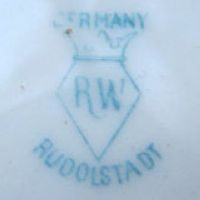
Image 011235-01-06
Used between 1904 and 1924, stamped version under "Germany" and above "Rudolstadt"'.
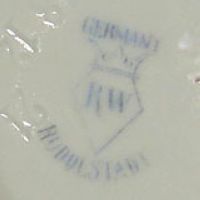
Image 011235-01-07
Used between 1904 and 1924, stamped version under "Germany" and above "Rudolstadt".
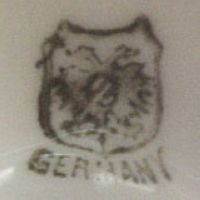
Image 011235-01-08
Used between 1904 and 1924, the not often used "Germany" version, registered under RWZR №·72·544 on September 30th 1904.
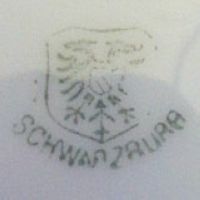
Image 011235-01-09
Used between 1904 and 1924, "Schwarzburg", simple shield.
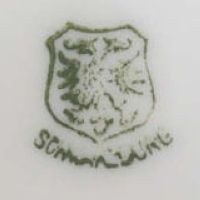
Image 011235-01-10
Used between 1904 and 1924, "Schwarzburg", more elaborate shield.
(Picture: Julie Haser)
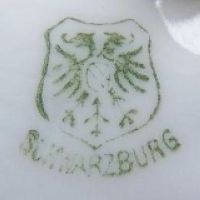
Image 011235-01-11
Used between 1904 and 1924, "Schwarzburg".
(Picture: Monika Birkl)
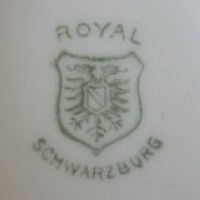
Image 011235-01-12
Used between 1924 and 1930, "Royal Schwarzburg" registered as RWZR №·325·632 on Dec. 16th 1924.
(Picture: Hans Hagebeuk)
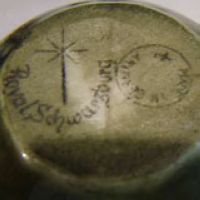
Image 011235-01-13
Used between 1926 and 1930, hard to find "Royal Schwarzburg" mark version with round "Made in Germany" addition.
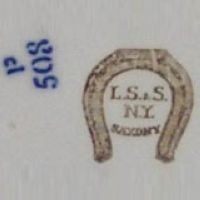
Image 011235-01-14
Claimed German subsidiary use but only found on direct imports from Saxony(-Anhalt), here on an item from the Annburger Steingutfabrik.
© 2004-2025 C.S.Marshall, all rights reserved